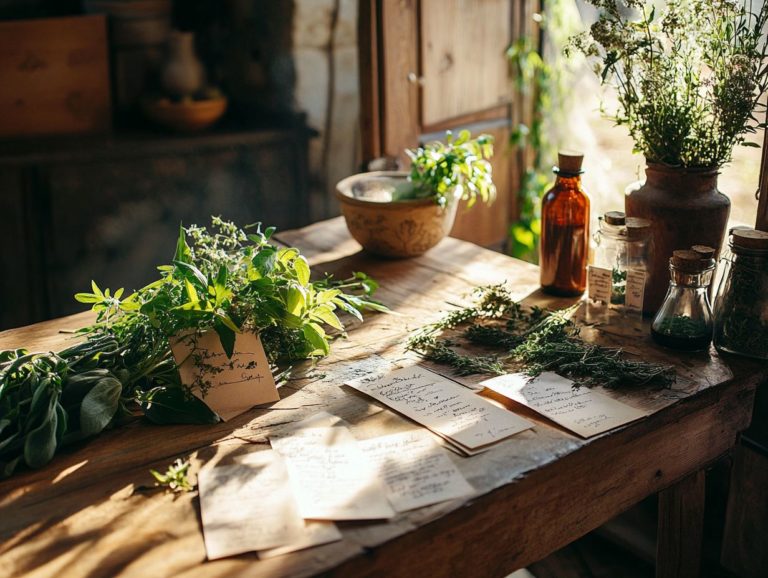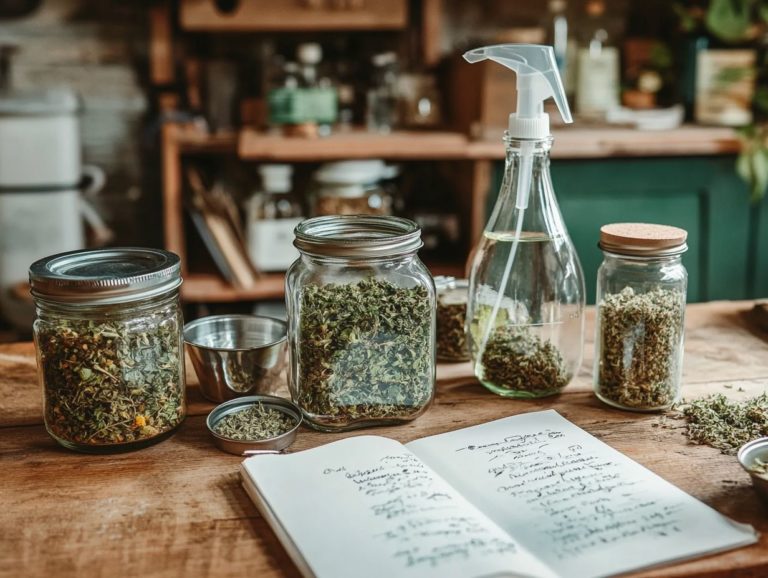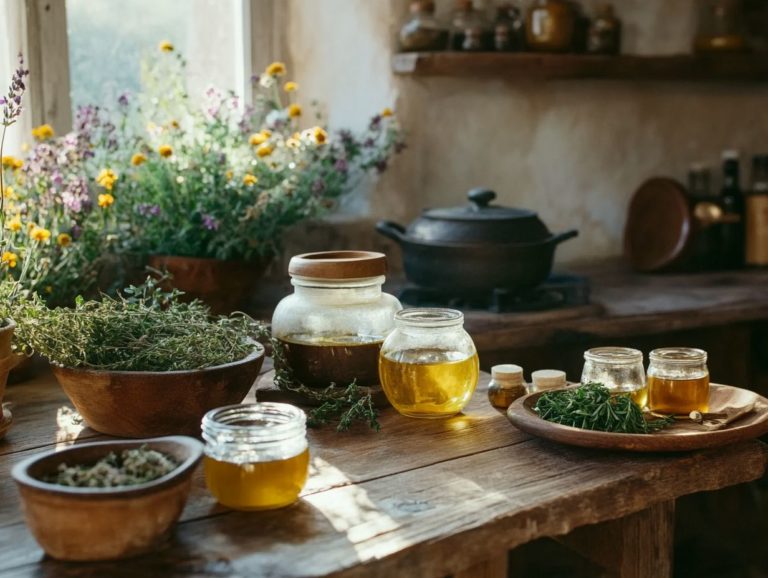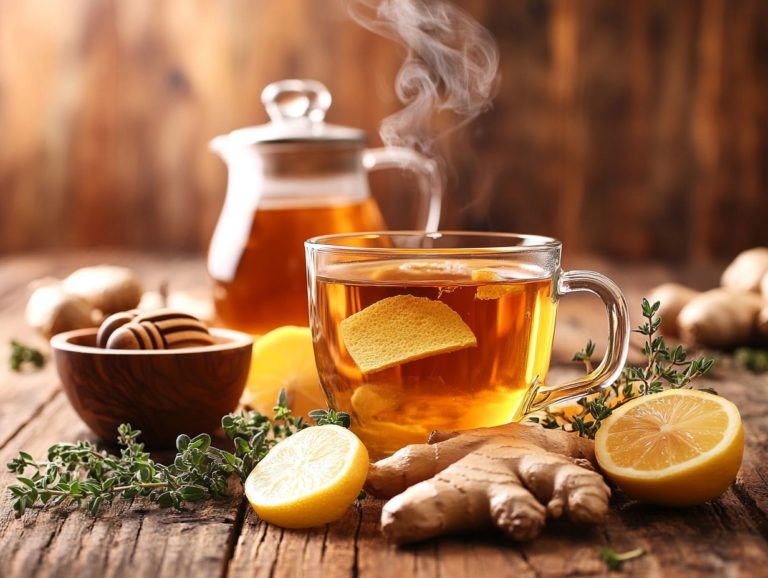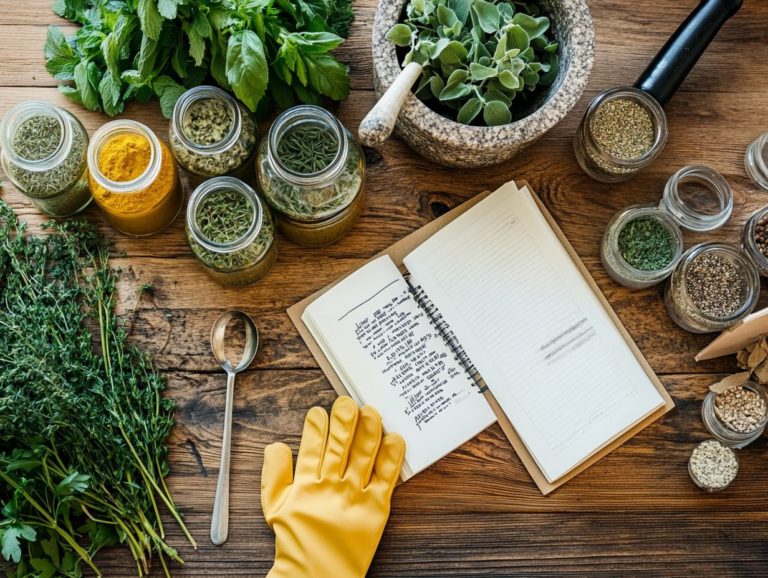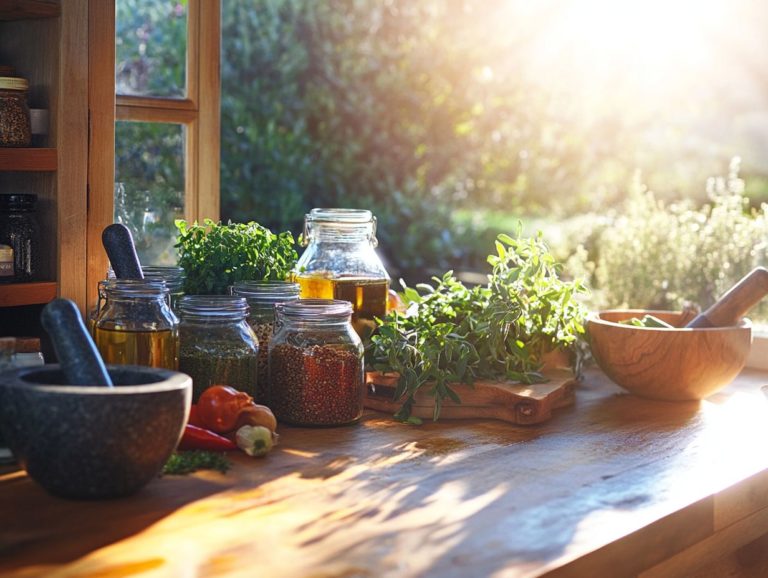Simple Steps to Create Herbal-infused Oils
Herbal-infused oils represent a delightful fusion of nature’s finest ingredients, offering numerous benefits for both health and beauty, especially through the use of various herbs and oils.
This exploration covers the healing benefits of these oils and how to select the right herbs for infusion. You ll discover various methods to create your own oils, including both hot and cold infusion methods. Along with practical tips for application and storage of your infused oils, you ll find essential safety precautions highlighted, especially regarding food safety to avoid issues like botulism.
Immerse yourself in the world of herbal-infused oils and unlock their remarkable potential, including the benefits of lavender-infused oil.
Contents
- Key Takeaways:
- Benefits of Using Herbal-infused Oils
- Choosing the Right Herbs for Infusing Oils
- Methods of Infusing Oils
- Using Herbal-infused Oils
- Safety Precautions
- Frequently Asked Questions
- What are the simple steps to create herbal-infused oils?
- Why should I use herbal-infused oils?
- What are the best herbs to use for herbal-infused oils?
- Can I use any type of carrier oil for herbal-infused oils?
- How long can I store herbal-infused oils?
- Can I use fresh herbs instead of dried herbs for herbal-infused oils?
Key Takeaways:
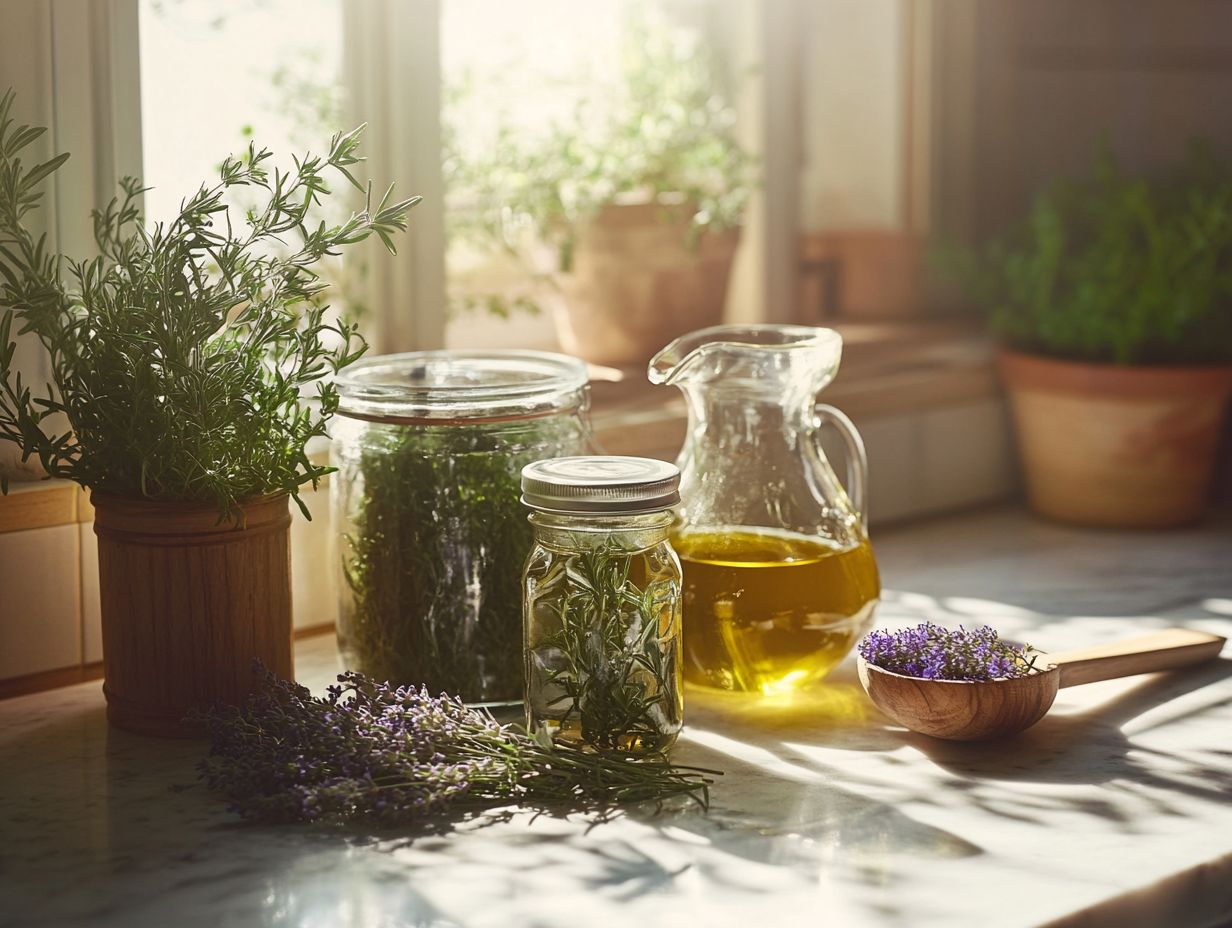
- Discover the benefits of using herbal-infused oils, such as their healing benefits in natural skincare products.
- Learn how to choose the right herbs for infusing oils by considering factors such as the desired outcome and safety precautions, including the importance of selecting the base oil used for infusing herbs.
- Learn hot and cold infusion methods to create the perfect blend for you, along with tips for using herbal-infused oils safely and effectively.
What are Herbal-infused Oils?
Herbal-infused oils are your go-to oil-based extracts, crafted by soaking a variety of herbs in a base oil to draw out their beneficial properties. This process results in versatile products perfect for both skincare formulations and culinary adventures.
You can infuse these oils with an array of herbs like lavender, rosemary, calendula, and peppermint, each offering its own unique benefits and delightful fragrances. By employing techniques such as heat infusion, cold infusion, or sun infusion, you can create customized blends tailored to your specific needs, enriching your journey into herbal preparations and natural skincare.
The choice of base oil plays a pivotal role in the infusion process, impacting both the effectiveness and aroma of your herbal preparations. Popular options like olive oil bring nourishing antioxidants to the table, while coconut oil is celebrated for its moisturizing properties and delightful aroma. These base oils not only act as the foundation for your herbal infusion but also amplify the therapeutic qualities of the herbs, allowing for effective herbal remedies. For instance, the fatty acids in olive oil can improve skin elasticity, while coconut oil’s antiviral properties add an extra layer of benefits, making them perfect for skincare formulations. To explore making your own blends, check out this guide on herbal oils.
Once you have your herbal-infused oils ready, the possibilities are endless. You’ll love applying them directly to your skin, using them in massages, or even incorporating them into your culinary creations, like salad dressings and marinades. If you’re interested in making your own topical applications, check out this guide on how to make herbal balm at home, showcasing their versatility and effectiveness in promoting overall wellness.
Benefits of Using Herbal-infused Oils
Incorporating herbal-infused oils into your daily routine presents a wealth of benefits, from elevating your skincare formulations to offering the healing benefits tied to the herbs themselves.
These oils are remarkable for their nourishing and hydrating qualities, delivering antioxidants like Vitamin E while boasting healing properties that can alleviate a range of skin conditions.
By embracing these natural skincare products in your regimen, you unlock the true potential of herbal remedies and foster an overall sense of wellness.
Ready to make your own herbal-infused oils? Grab your favorite herbs and let s get started!
Therapeutic and Medicinal Properties
Herbal-infused oils are a treasure trove of therapeutic and medicinal properties, improving traditional herbalism and modern skincare. The unique combinations of active compounds extracted from herbs like rosemary, peppermint, and plantain allow you to target specific treatments for various ailments, from inflammation to antibacterial needs, showcasing the rich potential of herbal remedies.
Each infusion can be finely tuned to cater to your unique conditions, embracing a holistic approach to health and wellness.
Take rosemary oil, for example, a popular choice in herbalism. It’s celebrated for its ability to stimulate circulation, potentially alleviating muscle pain or tension no wonder it is a go-to for massage therapists.
On the other hand, peppermint oil offers a refreshing burst that can help clear headaches and sharpen focus, especially in the realm of aromatherapy.
Don’t overlook plantain either; its skin-soothing properties make it a reliable ally for minor cuts or irritations.
By incorporating these infused oils into your daily skincare routine, you not only enhance the effectiveness of topical treatments but also foster an overall sense of well-being.
Choosing the Right Herbs for Infusing Oils
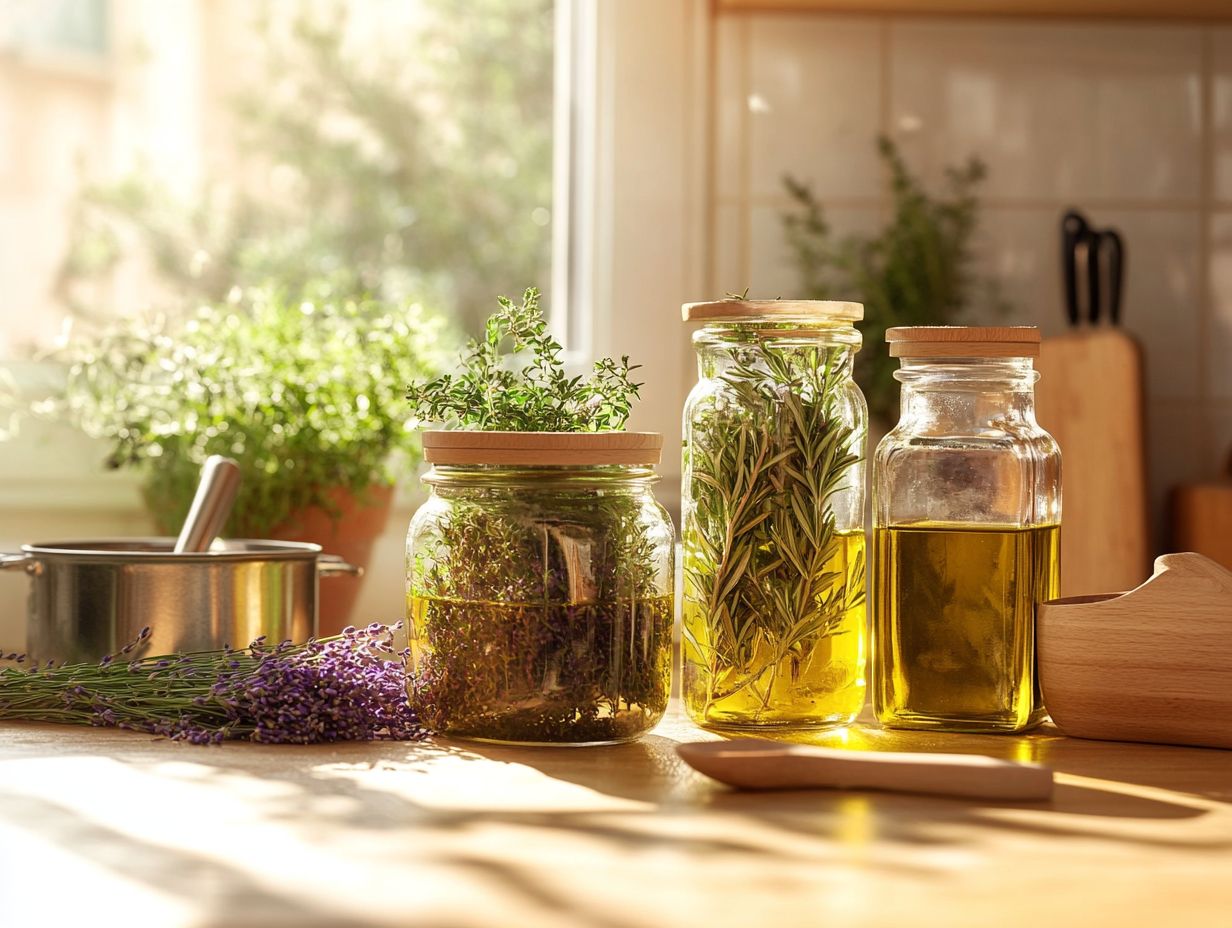
Choosing the right herbs for infusing oils is essential for achieving the therapeutic effects you desire while elevating the quality of your herbal preparations. Think carefully about factors such as each herb’s specific healing properties, how well they mesh with your chosen carrier oil, and your individual skin type. This thoughtful approach ensures the effectiveness of your herbal-infused oils.
Popular selections like lavender, rosemary, and calendula each offer unique benefits, making them excellent candidates for a variety of skincare formulations.
Factors to Consider
When selecting herbs for your herbal-infused oils, such as lavender and rosemary, it is essential to consider several factors to ensure optimal results and effectiveness. Reflect on the medicinal properties of each herb, their scent profiles, the intended use of your infusion, and how well they pair with various carrier oils for skincare formulations.
Careful selection makes your final product more effective. The medicinal properties of herbs are crucial; each plant offers unique therapeutic benefits, whether it’s soothing inflammation or boosting circulation. Don t overlook the importance of scent; certain aromas, like the calming scent of lavender, can evoke specific emotions or promote relaxation, making your infusion not only effective but also enjoyable.
Understanding your intended purpose is key whether it s for massage, skincare, or general wellness allows for targeted selections that optimize benefits. Pairing your chosen herbs with compatible carrier oils can amplify their properties, ensuring that the infused oil not only delights the senses but also works harmoniously with the skin, leading to an enriching experience overall, particularly in skincare formulations.
Methods of Infusing Oils
There are various methods for infusing oils with herbs, each presenting different benefits and times for infusion that can greatly influence the potency of the final product.
The heat infusion method is one of the quickest options available, helping you create herbal-infused oils quickly. For those interested in making your own products, you might find homemade herbal salves particularly useful. Conversely, the cold infusion method excels at preserving the delicate properties of more sensitive herbs, ensuring their essence remains intact.
Then there’s the sun infusion method, which harnesses the gentle power of sunlight over an extended period, resulting in richly aromatic and potent herbal oils, a favorite among seasoned herbalists. For those interested in making their own blends, check out this guide on how to make your own herbal tea at home. Experience the incredible benefits of each method!
Hot and Cold Infusion Techniques
Hot and cold infusion techniques are two prominent methods for crafting herbal-infused oils, including oil made by soaking herbs in another oil, each offering unique advantages tailored to your specific needs. The heat infusion method speeds up the extraction process, allowing for quicker preparation and concentrated flavors perfect for robust herbs and ideal for culinary uses.
In contrast, the cold infusion method preserves the delicate properties of the herbs, resulting in a milder, fragrant oil that is particularly well-suited for sensitive applications, including skincare formulations and herbal syrups.
When deciding between these two approaches, consider the specific herb at hand, such as rosemary or peppermint, and the outcome you aim to achieve. Hot infusions typically extract essential oils more thoroughly, yielding richer, bolder flavors that shine in culinary uses like salad dressings or marinades.
However, this method may diminish some volatile compounds, making it less ideal for herbs with delicate aromas, such as lavender.
Cold infusions, while a bit slower, maintain the original characteristics of the herb, producing a subtler oil that may be more desirable for cosmetics or gentle therapeutic applications. To achieve the best results, pay attention to the proper temperatures for hot infusions and allow for a longer steeping time with cold methods. For those looking to enhance their skills, consider learning how to create herbal tinctures easily. Both factors can significantly influence the oil’s final potency and aroma, impacting the effectiveness of your herbal preparations.
Using Herbal-infused Oils
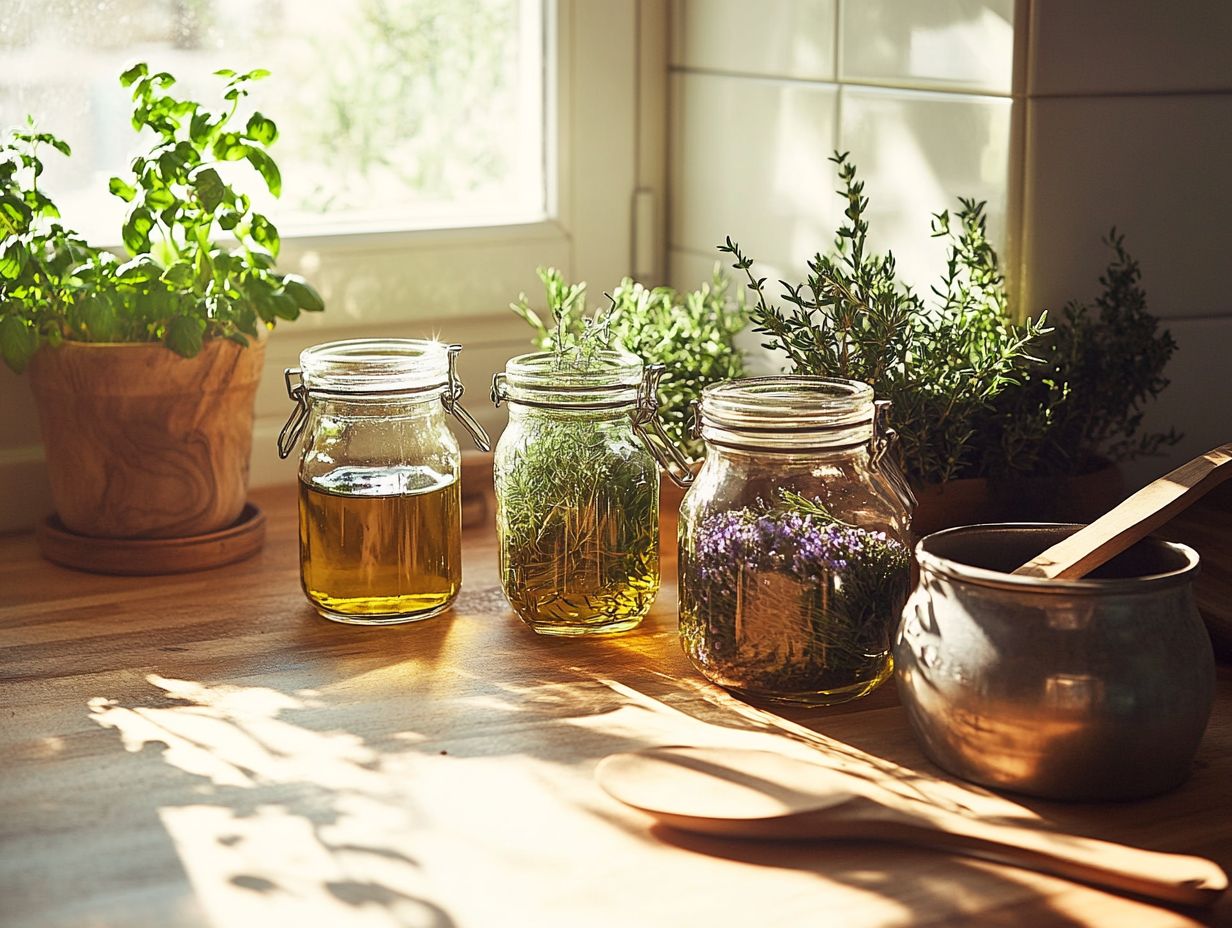
Incorporating herbal-infused oils into your daily routine can elevate your skincare regimen while adding a delightful aromatic flair to your culinary endeavors. These oils serve as versatile enhancements, transitioning from natural skincare products to exquisite culinary creations.
You can apply them directly to your skin or blend them with various ingredients to craft custom formulations tailored to your unique needs. To maximize their potency and effectiveness in both skincare and culinary uses, mastering proper storage techniques is essential. This ensures that these herbal treasures remain beneficial for as long as possible.
Application and Storage Tips
Know your skin type to maximize benefits when applying herbal-infused oils, such as comfrey or calendula-infused oil. For instance, the healing properties of calendula-infused oil work wonders on cuts and abrasions, while lavender-infused oil offers soothing relaxation in aromatherapy.
Store these oils in a cool, dark place, preferably in a glass container, to enhance their shelf life and protect them from degradation caused by light and heat. Incorporating Vitamin E improves their longevity.
Understanding the nuances of each herbal oil can be pivotal for your skincare routine. Take tea tree oil, for example it’s fantastic for acne-prone skin, as its antibacterial properties effectively combat blemishes. Many enthusiasts also explore oil made by soaking herbs in another oil for its benefits.
When using these herbal options, incorporating a carrier oil is advisable, especially for sensitive skin types. To ensure longevity, steer clear of plastic containers, which can leach chemicals and compromise the oil s potency.
Opt for amber or cobalt glass bottles to protect the oils from light while adding a touch of elegance to your skincare shelf. This makes them an attractive and accessible choice for daily use or specific aromatherapy sessions. This practice is endorsed by experts like Whitney P. Bowe from New York.
Safety Precautions
When utilizing herbal-infused oils, it s essential to adhere to safety precautions to mitigate any potential risks linked to their application and storage. Be mindful that certain herbs may trigger allergies or skin sensitivities. Poorly prepared infused oils can pose serious health risks, such as botulism a serious illness caused by bacteria that can thrive in improperly prepared oils especially if they contain moisture-rich ingredients.
By ensuring meticulous preparation and proper storage, as well as familiarizing yourself with the properties of each herb, you can significantly reduce these risks. This enhances the safe and effective use of herbal remedies, a principle highlighted by Rosalee de la For t.
- Store in a cool, dark place.
- Incorporate Vitamin E for longevity.
- Use amber or cobalt glass bottles to protect from light.
Don’t wait! Elevate your skincare routine now!
Potential Risks and How to Avoid Them
Herb-infused oils offer wonderful benefits! However, it s essential to know the potential risks to enjoy them safely. You should be aware of allergic reactions to certain herbs, the possibility of contamination from improper storage, and the risk of botulism from moisture-laden oils, particularly if you re using delicate herbal combinations in your own experiments.
By following proper preparation guidelines and trying a small amount first before full application, you can relish the benefits of herbal remedies with greater peace of mind.
Recognizing your sensitivities to herbs is crucial. Reactions can vary, so document your experiences to catch any adverse effects early.
Proper storage is also important. Keeping your oils in a cool, dark place helps prevent spoilage and extends their shelf life.
Maintaining a clean environment throughout the preparation process can significantly reduce contamination risks. This ensures you have a safe and effective product.
By being proactive and well-informed, you can fully appreciate the diverse applications of herbal-infused oils, including their medicinal properties in skincare routines.
Watch this video for a quick guide on creating herbal-infused oils!
Frequently Asked Questions
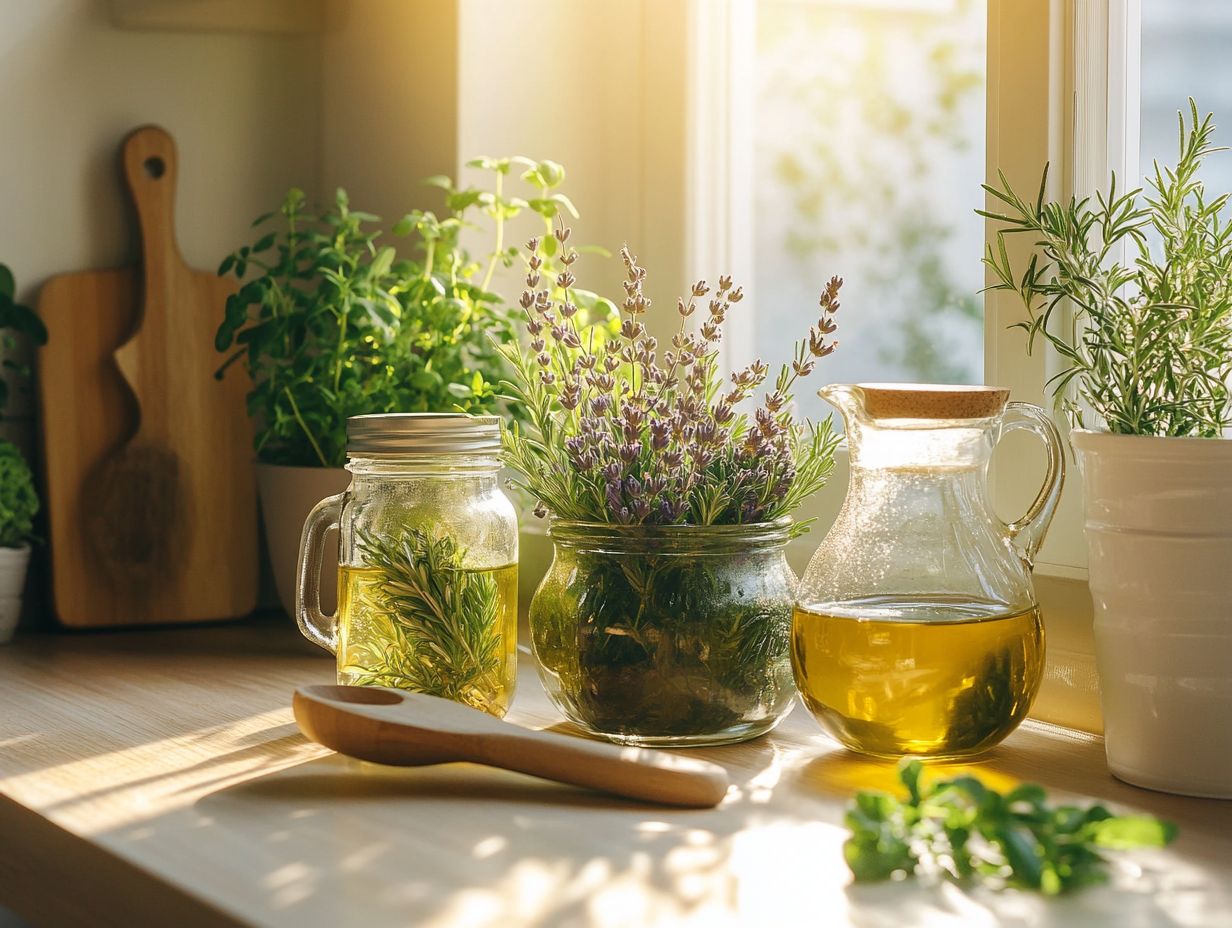
What are the simple steps to create herbal-infused oils?
To create herb-infused oils, you need your choice of herbs, a carrier oil, a jar, and patience. Follow these simple steps:
- Chop or crush the herbs and place them in a jar.
- Pour the carrier oil over the herbs until they are completely covered.
- Seal the jar and place it in a warm, sunny spot for 2-4 weeks.
- Strain the oil and store it in a dark container for future use.
Why should I use herbal-infused oils?
Herbal-infused oils have many benefits, including:
- Used in natural skincare and haircare.
- Medicinal properties for various ailments.
- All-natural and chemical-free.
- Longer shelf life than fresh herbs.
What are the best herbs to use for herbal-infused oils?
The best herbs to use for herbal-infused oils depend on your specific needs. Here are some popular choices:
- Lavender for relaxation and stress relief.
- Calendula for soothing skin irritations.
- Peppermint for headaches and digestion.
- Rosemary for hair growth and scalp health.
- Chamomile for calming and promoting sleep.
Can I use any type of carrier oil for herbal-infused oils?
Yes, you can use any type of carrier oil for herbal-infused oils. Some popular choices include:
- Olive oil for its moisturizing properties.
- Coconut oil for its anti-inflammatory and antibacterial properties.
- Sweet almond oil for its nourishing and soothing properties.
- Jojoba oil for its similarity to the natural oils of our skin.
- Grapeseed oil for its lightweight texture.
How long can I store herbal-infused oils?
If stored properly in a dark container, herbal-infused oils can last up to a year. However, it’s best to use them within 6 months for maximum potency. Make sure to check for any signs of spoilage before using the oil.
Can I use fresh herbs instead of dried herbs for herbal-infused oils?
Yes, you can use fresh herbs for herbal-infused oils. However, they may have a higher water content, which can increase the risk of spoilage. Make sure to thoroughly dry the herbs before infusing them in oil, and keep an eye out for any signs of spoilage during the infusion process.
Ready to try making your own herbal-infused oils? Let s get started!

